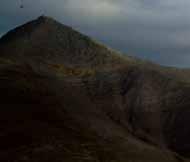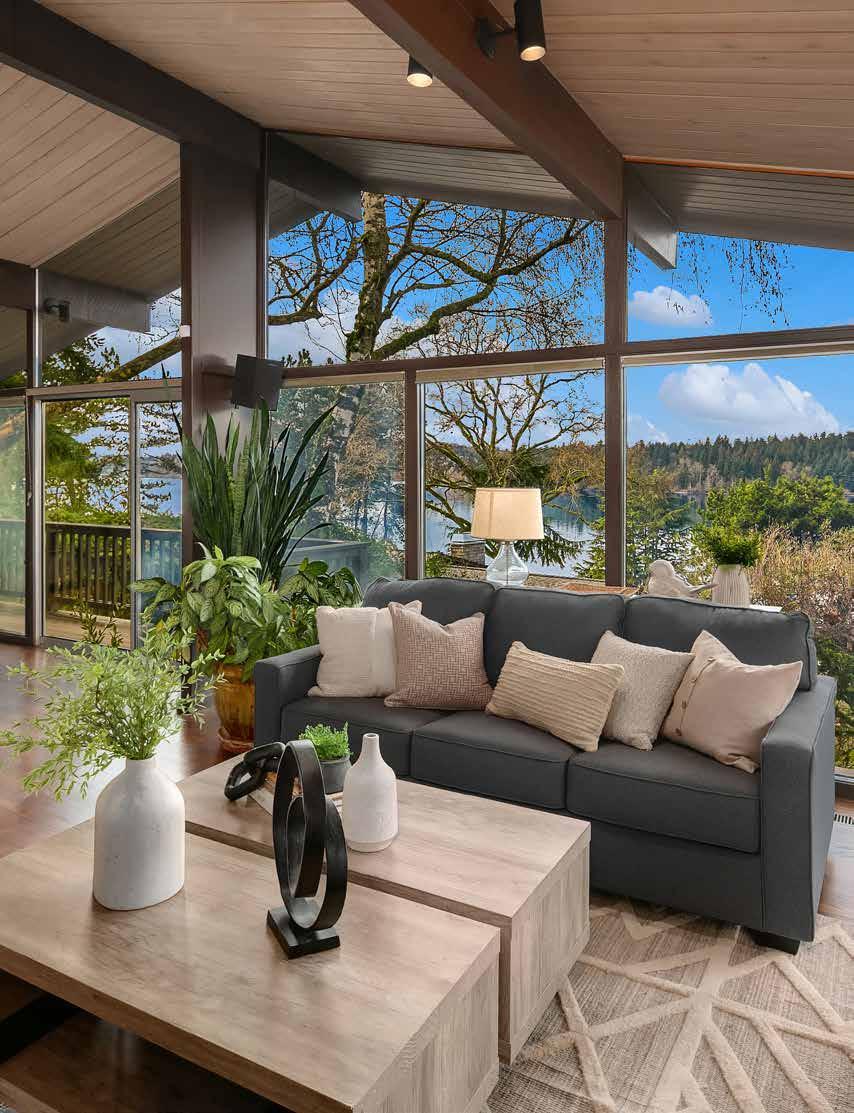












Dear Islander,
Summer is here—and with it, a renewed appreciation for connection, craft, and time well spent. This month, we celebrate the men shaping the spirit of Mercer Island through design, leadership, creativity, and care.

Our cover story, Gents Shaping Style, Sound, Flavor, and Design on Mercer Island , introduces six dynamic individuals: Stu Denman, the modern cre ative fusing tech and imagination; Sunil Kumar, a global style authority with sharp local sensibilities; Ed Kashiba and Jason Farrish, culinary innovators redefining taste; Marc Russo, a master of mood through music; and Hill Harper, the actor and gracious host behind ASA Gathering. Each brings something original to the table—and to the Island.
You’ll also discover how “man caves” have evolved. Gallagher & Co., Hi-Tek Group, and Baklinski Home Improvement are building multi-functional retreats— from home theaters to wine lounges—that begin as personal sanctuaries and end up as the most-loved rooms in the house.
In Rewriting the Neighborhood , we explore House Bill 1110, a game-changing zoning law that opens the door to backyard cottages, multigenerational living, and more attainable homeownership. With insights from Dean Jones, Tadashi Shiga, and Matthew Gardner, it’s a story about smart growth—and shaping community with intention.
You’ll meet Gary Furukawa, a visionary who saw the future of wealth management long before it became mainstream. You’ll hear from Dr. Peter Brown about the timeless bond between men and their dogs. And you’ll join Hill Harper again, this time inside ASA, where hospitality meets soul.
Finally, if your summer plans call for something extraordinary, Brenda El-Ghazzawy of Luxxe Travel shares curated lodge experiences across the American West and Alaska. From Montana’s fly-fishing ranches to Sitka’s oceanfront escapes, these adventures blend grit and grandeur for those who seek the wild—without sacrificing comfort.
This issue isn’t just about celebrating men. It’s about honoring what they build, how they gather, and the way they show up—for their families, communities, and passions. We hope it inspires a summer full of meaning, beauty, and bold new memories.
Warmly,
CHRIS ISHII & SHARON PEREZ @MERCERISLANDCITYLIFESTYLE/
PUBLISHER
Chris Ishii | chris.ishii@citylifestyle.com
EDITOR
Sharon Perez | sharon.perez@citylifestyle.com
CONTRIBUTING WRITER
Brenda El-Ghazzawy
CONTRIBUTING PHOTOGRAPHERS
J Garner Photography, Les K Lee, Sasha Reiko, Kara Mercer, Tim Van Asselt, Emily Minton Redfield,
Travel
CEO Steven Schowengerdt
COO Matthew Perry
CRO Jamie Pentz
VP OF OPERATIONS Janeane Thompson
VP OF SALES Andrew Leaders
AD DESIGNER Evan Deuvall
LAYOUT DESIGNER Kelsey Ragain
QUALITY CONTROL SPECIALIST Hannah Leimkuhler


Learn how to start your own publication at citylifestyle.com/franchise.



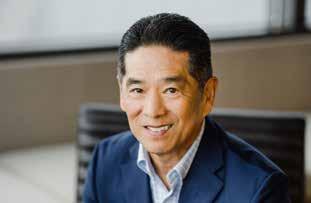

“RE-Vesta Group demonstrated unwavering support and professionalism throughout the search and acquisition of my son’s new home. Coming from another country, their expertise and dedication were especially valuable to us. We felt reassured knowing we had such capable professionals by our side. They made the entire process seamless and stress-free.” - FATHER
“I’m very grateful for Robyn’s and Rachel’s expertise and dedication. It made what could have been a stressful process much smoother. I highly recommend their group to anyone looking for knowledgeable and reliable Realtors!” - SON
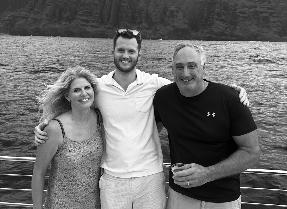



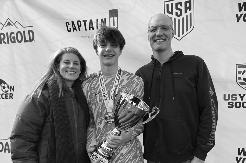
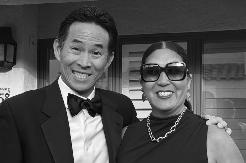



















The Futurecast Forum is a real estate industry think tank offering timely insights, expert perspectives, and interactive events to help you stay informed and activated within an ever-changing housing market landscape.
This month, we’re proud to share the release of our 2025 Market Report—a comprehensive look at the economic forces, housing trends, and policy shifts influencing real estate across our region. Designed to support confident decision-making, this resource empowers buyers, sellers, brokers, and investors alike.
Inside the report:
•2025 Housing Overview
•Mortgage & Inflation Trends
•House Bill 1110 Impact
•$90 Trillion Great Wealth Transfer
•Local Market Data Highlights
•New Development & Urban Demand

Dean Jones President and CEO Realogics Sotheby’s International Realty
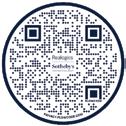
Explore the insights and discover what’s driving the market—and how it may impact your next move.








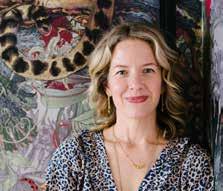

The Robyn & Rachel Group of Realogics Sotheby’s, present the Re-Vesta Group with an expanded team. Partner & Principal Broker Robyn Kimura Hsu and Partner & Managing Broker, Rachel Schindler have added four additional professionals to their team: Jill Smith, Krissi Ayad, Jenn Burke and Maddie Bates. The new name is inspired by Vesta, the Roman goddess of hearth and home, reflecting their commitment to creating spaces of warmth, stability and lasting value.
Scan to read more
Breakthrough mental health brand Therapy Lab is now in Seattle-Bellevue! Founded by psychologist Dr. Chandler Chang. Therapy Lab delivers efficient, focused, science-backed therapy plans designed for real life. From anxiety and insomnia to self-confidence and emotional clarity, clients get practical tools that work—smart therapy for modern life. Prioritize your well-being. Own your goals. Thrive with Therapy Lab.
Scan to read more
ASA is open every day, and well into the night! 8am - 12am Sunday - Thursday, and 8am to 2am on Friday - Saturday.
ASA added coffee and daytime service to the cocktail bar. Both are managed with expert professionals. Bar manager and celebrity bartender, Joe Dietrich , recommends Blanco Tequila using 100% estate-grown Blue Weber agave.
“Each batch is unique,” Joe shared, “and this particular one is one of the best I’ve ever had.”
Scan to read more

ARTICLE BY SHARON PEREZ & CHRIS

THE CONNOISSEUR, STYLE AUTHORITY, MUSIC MAN, TASTE MAKERS AND THE MODERN CREATIVE
Explore the work of a man blending innovation and art
A deep dive into innovation, imagination, and interactive design
1. Creative Origins
• How did your journey into game and app development begin? Was there a pivotal moment or project that set you on this path?Two words are meaningful to me when I think of my origins in games and technology: Mentorship and Limitations. When I was a little kid, my friends had game consoles like the Atari 2600 and my parents were not big into buying the latest technology. Our 8’ square TV was still black and white in the 80’s. This limitation made me dream about what it would be like to play video games at home on a big color TV. So as a kid, I did a lot of hands-on creative play, things like legos, art and photography and continued to take art classes through high school. In middle school at age 12, I met an amazing math+photography teacher, Mr. Wahle, who had a classroom full of computers, which was pretty unusual for my small town. He ran an after-school computer club, but it was basically a bunch of geeks hanging out, being silly, making games and programming computers to fill the screen with colorful visuals and sounds. The next Christmas, I was heading to bed and found a large
present blocking the stairs to my room. Inside was my own computer, which was a pivotal moment for me, and showed my parent’s great support for my interests.
Another hugely pivotal moment was when I started my first game studio, Surreal, which really taught me so much about all the pieces and roles involved in making and marketing a good game. I started Surreal, incidentally, with another long-time Mercer Islander, Nick Radovich. Surreal was a relatively independent and vibrant game studio for 15 years before being merged with Warner Brothers Games.
2. Design & Development Process
• Can you walk us through your creative process when developing a game or app? Where do you start—mechanics, story, visuals?I start with the mechanics (interactive experience) and the visuals. I’m a bit obsessed with making something new and original, so I do a lot of research to make sure I’m exploring a space that hasn’t been done before. Usually that means there are difficult problems to solve. Otherwise people would have done it before, right?
I would describe my creative process as “organic” and “playful” which means I don’t have a lot of structure or a particular goal in
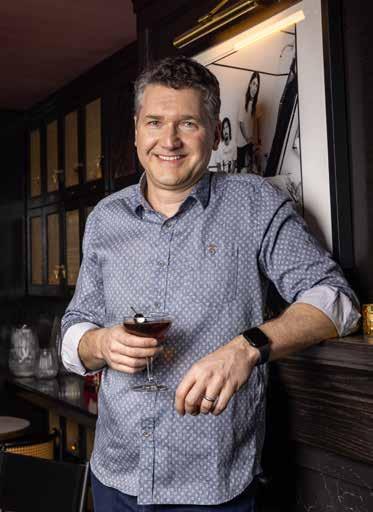
mind, other than I’m looking for fun new experiences with a particular game mechanic. So for example, when I designed Tiny Bubbles, I was intrigued by the structure and movement of soap bubbles and I had a strong gut feeling that there was a fun game in this idea. I wasn’t sure exactly what it was until I jumped over a lot of hurdles to bring this strange physics to life on the screen. Once I was convinced of the potential, then I had my co-designer and I just play with different ideas, start tossing bubbles up on the screen and see how they behave and the puzzles come to life out of that play.
• How do you balance form and function—making something that’s beautiful and intuitive?This is a very difficult problem, even more than simulating the molecular dynamics of soap bubbles! It helps to have a sense for what looks good and what does not because if you have this sense then I find any design skills you lack can usually be learned. It’s important to keep things simple. If you can explain something in a game without words, that’s better for a frictionless first time player experience. I personally gravitate toward complicated things and so I won’t necessarily remove complicated puzzles from the game, but I will move them to appear later in a player’s journey so they can work up to this level of challenge.
3. Inspiration & Influence
• Where do you draw inspiration from—games, art, architecture, real-life experiences? Other games are certainly a big influence to all game designers, but art and nature are my biggest inspirations. Nature has evolved into these unbelievably beautiful structures, colors, and behaviors that for me provide an endless bounty of untapped ideas. I
suppose I’ve always been as much a scientist as a creator. But ideas can come from anywhere. My Grandfather was a huge influence on my interests, as is my wife and 2 boys. While the soap bubble idea came from my Grandfather, if you think about it, foam bubbles are literally right in front of us every day whenever we wash our hands. We’re just so used to seeing it, from babyhood, that its incredible charm is practically invisible to us.
• Are there designers, creators, or studios whose work you admire or who’ve influenced your own style? There are too many to name! I love the visual design, simplicity and playfulness of the Monument Valley series by UsTwo Studios, which could not exist without M.C.Escher who I admire tremendously. Also other game developers who made impossible-object games before it, like Echochrome and Hocus. There have also been some influential talks at the Game Developers Conference over the years, such as by Zach Gage, Will Wright, and the famous “Juice It or Lose It” talk, which showed how simple “feedback” animations to player actions can make even a simple game feel so much more alive and fun.
• What do you think games and interactive experiences can teach us about culture, creativity, or even ourselves? To think more flexibly and to appreciate the beauty of diverse perspectives. This is true for many artforms. Art isn’t made for everybody, it’s made for somebody. Not everything is made for you but that’s OK and that’s a good thing. People review artworks, games and restaurants as if they were designed just for them and then pan it with great passion. I find this amusing, which probably helps me have a thicker skin!
Also collective creation. So just like a restaurant, games often require a group of talented individuals to work together to create something wonderful and those different selves make a better whole. Beauty can also come from lack of control and a collective work can manifest this idea sometimes better than one created by an individual artist.
• How do you approach creating something that resonates with people across different ages and backgrounds? This shouldn’t always be the goal, but for Tiny Bubbles it definitely was and so I approached it with kindness, respect and “play” as the primary design pillars. Respect for players is unusual in my business, which is primarily mobile games. It is dominated by big data where every cent is squeezed out of players using psychologically-manipulative techniques. Unfortunately it works, but turns off many players to what would otherwise be a fantastic gaming platform in the hands of nearly every person on earth!
5. Favorite Projects
• Is there a project you’re especially proud of—either for how it turned out or what you learned in the process? Tiny Bubbles for sure, but not just because of the dozens of awards it has won (which I’m obviously very grateful
for that recognition), but because it was the first project that I designed and built from my own inspiration and leadership, as opposed to an idea created by other people on the team.
Also I’m very proud of my work with the Seattle Universal Math Museum, which is still very much a work in progress but has made a real impact in the community. Creativity is very important here, because we’re showing kids that math isn’t just the rigor of traditional math curriculum, but can have a rich visual and interactive appeal that we mistakenly omit from school learning.
• What’s one challenge you overcame in development that ended up making the work stronger?Definitely the physics simulation that underlies the Tiny Bubbles soap was an incredible challenge to overcome and a leap of faith because I had to spend 3 weeks getting this physics to work before I knew if the game was going to be fun or not. I was learning this Ph.D-level math and also trying to make it calculate fast enough to run on a mobile phone!
This is a classic interview question, but it’s classic for a reason because it vets our perseverance. It’s important to acknowledge that not just the challenges and hurdles, but mistakes make us and the work stronger. It’s critical to teach our kids at home and at school to recognize that successful people have just made more mistakes and failed more than unsuccessful ones.
• What keeps you creatively inspired or curious day to day?I think I hopefully answered this above in Section 3.
• How do you recharge or reset when you hit a creative block?I usually put things on the back burner and let them “cook” a bit more. I believe our brains do a lot of creative thinking and problem solving while we sleep, so I don’t see sleep as unproductive time like I used to in college. Lately I’ve been using AI chat to help me think more creatively and problem solve, but I think coworkers are an excellent help as well, which I don’t surround myself with enough of, these days.
7. Quick Tap
• First video game you ever loved? Ballblazer by LucasArts.
• App you wish you had built? Monument Valley (Creative me) or YouTube (Business me)
• Favorite soundtrack from a game? It’s a tie between Hexic and Minecraft
• Go-to creative snack or beverage? Mocha, iced in summer, hot the rest of the year.
• Three words that describe your design aesthetic? Playful, Graphical, Mysterious

Dual Identity – Builder by Day, DJ by Night
How do those two worlds intersect or influence each other?
People are always surprised when they learn I’m both a homebuilder and a DJ—but to me, they’re both acts of creativity and connection. At JayMarc Homes, we don’t just build luxury homes—we create a memorable experience by helping clients bring their dream to life. DJing taps into that same mission.
It’s about playing music that makes people feel happy, connectedand energized.
And then there’s my third world: writing my book, Inspire Happiness: Create a Blueprint for a Happy Life. That work is about helping others design their own version of joy and purpose. Whether I’m building a home, curating a DJ set, or writing a book, it all comes back to the same thing—creating spaces where people can thrive.
Musical Beginnings – The Spark of Sound
When did you first start DJing? What sparked your passion?
My DJ journey started in 1990 at the University of Washington with my business partner and great friend, Jay Mezistrano. DJing was actually our first entrepreneurial venture—we spun music at nearly every fraternity and sorority party across campus. We built friendships, packed dance floors, and had an absolute blast.
In 1995, we sold the business so we could go full-time into real estate. That’s when we started buying fixer homes across Seattle—and JayMarc Homes was born from that leap. But the love for music never left.
The Creative Process – Flow Meets Intention
How do you prepare for a DJ set?
In 2019, after a 25-year break, I felt the pull to start DJing again. At first, it was small parties, fundraisers, and local charity events. But one day, I set a big, crazy goal: to DJ in clubs and festivals around the world. That dream took three years—and a global pandemic—to achieve.
I had to relearn everything from scratch: new equipment, creating original music, and building a personal brand on social media. Once I understood the technical and creative landscape, I had to find my place in the world of DJing. I landed on becoming an opening DJ—the one who sets the tone for the night, building energy without overshadowing the headliner.
That role is an art form. It’s about curating a mood—getting people excited while holding back just enough to create anticipation. Preparing a set often takes hundreds of hours for just one hour of music. I blend tracks that flow seamlessly, mixing familiar favorites with fresh new finds to keep the energy building without ever breaking it.
Culture & Community – Music as Emotional Connection
What role does DJ culture play in shaping community?
Music is one of the greatest emotional connectors we have. A song can instantly transport you back to a moment when you felt alive, free, or loved. That’s what I love about DJing—it’s a gateway to happiness. People let go of stress, come together, and just feel.
One of my favorite gigs was at Belly Up in Aspen, a legendary 450-person club that attracts some of the world’s biggest acts. I got to open for Claptone during two soldout shows. People flew in from around the world, and my wife was there with me—it was one of those unforgettable moments where everything just aligned.
Influences & Icons – Soundtrack of a Life
Who are your biggest musical influences?
From the old school: Roger Sanchez, Carl Cox, Frankie Knuckles, and Masters at Work—the legends who laid the foundation. From the new wave: Fred again.., James Hype, and ODESZA. All of them tell stories through their sets. They don’t just play music—they create a journey.
An album or track that changed your life?
“You Don’t Know Me” by Armand Van Helden. That track opened my eyes to how music could be bold, soulful, and emotionally raw all at once.
Guilty pleasure track?
“Music Sounds Better with You” – by Stardust timeless, feel-good, and impossible not to dance to.
Best crowd you’ve ever played for?
Hands down, Stereo Live in Houston and Dallas. Two sold-out shows, 2,000+ people, opening up for Claptone—a bucket-list moment. That’s when I knew I had achieved the dream I set for myself years before.
What was your dream DJ gig?
Miami Music Week at the SLS Hotel Hyde Beach. I had the honor of opening for Fatboy Slim, Claptone, and James Hype— all in one weekend. Even better, I had eight of my best friends fly down to celebrate with me. It was everything I’d imagined and more.
Three words that describe your vibe behind the decks?
Happy. Creative. Fun
The Modern Gentleman. A look into the wardrobe, mindset, and rituals of a man who leads with quiet confidence and timeless style
Style Origins - How would you describe your personal style in a few words?
Casual, a little bold, and elegant. I love plaid pants and jackets—mixing things up keeps it interesting.
Where did your sense of style come from? Have you always been drawn to fashion, or did it evolve over time?
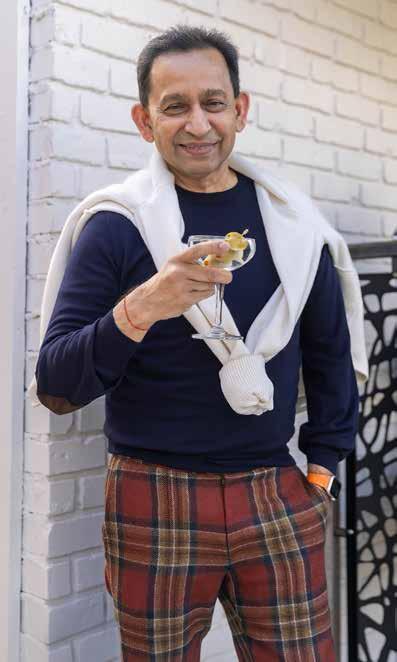
My mother always dressed me well, and my grandfather had his suits custom-made by a tailor. As a kid, I’d even bring my own ideas to the tailor. I’ve always loved style—GQ was a big influence. To me, clothes are a reflection of your personality, your confidence, and your ability to connect. They don’t define you, but they can express something you love—and my wife and daughter appreciate that.
The Signature Look - Is there a go-to piece in your wardrobe that you feel most yourself in?
I’ve worn Brunello Cucinelli for over 20 years. I usually go with Cucinelli pants, Isaia jackets, and suede shoes—especially from Bontoni. Shoes make a huge difference. I also love knits and polos for a relaxed, polished feel.
How do you balance looking sharp with the laid-back vibe of the Pacific Northwest?
The Northwest definitely leans casual, but I like to dress a little differently—casual pants, knits, and tailored jackets from my favorite designers. Over time, I’ve found a way to express myself while staying comfortable and appropriate for the setting.
Where do you love to shop—locally or online?
I’m a loyal client at Mario’s in Seattle, where I work with my style advisor, Chris. They know my whole family, and I order new pieces every season—Zegna, Isaia, Kiton, and of course, Cucinelli. For online shopping, I go to Gucci, Prada, Farfetch, and Neiman Marcus. I also have a great style advisor for those.
Do you work with a tailor? How important is fit when it comes to making a statement?
Fit is everything. Even the best clothes don’t look good if they don’t fit properly. Sue’s Tailoring is phenomenal—she can make anything look couture. I also work with tailors at Mario’s, especially during trunk shows.
What role do you think style plays in how others perceive you— and how you feel about yourself?
Style sends a message before you say a word. It’s not about impressing others—it’s about feeling confident, being thoughtful in how you present yourself, and creating a sense of connection.
Favorite spot on Mercer Island for a quick pick-me-up or relaxed meeting?
Barrels Wine Bar—I run into so many friends there, and the staff is incredibly welcoming. I also enjoy the South End Starbucks. The baristas there are great to talk with.
Any barbers, tailors, or shops in the area you’d recommend?
I stay loyal to the people who know my style. Charlie at Salon Louis in Bellevue is my go-to.
What does being a “modern gentleman” mean to you today?
It’s not just how you dress—it’s about your attitude, your behavior, and your willingness to listen. A gentleman is defined by confidence, thoughtfulness, and how he relates to others. And one of the best accessories? A smile—and it’s free.

You may know Hill Harper as an acclaimed actor, bestselling author, and humanitarian—but step inside ASA Gathering, and you’ll meet Hill the host. Hill the curator. Hill the connoisseur of spirits who has quietly created one of the most thoughtful and inviting spaces on Mercer Island.
ASA isn’t just another bar—it’s a sanctuary of connection. From the moment you enter, the lighting softens, the world
How do you define elegance or sophistication in a world that’s increasingly casual?
It comes down to grooming, fit, and a few well-chosen accessories. You don’t need a huge wardrobe—just well-fitted clothes, polished shoes, and details like a pocket square, scarf, or colorful socks. I always keep a comb and a handkerchief in my pocket. Those small touches make a difference.
Quick Stitch: Rapid Fire Round Tie or no tie?
No ties since leaving Silicon Valley.
Coffee or wine?
Coffee in the morning. Wine in the evening—usually red, but I enjoy experimenting with whites and rosés in the summer. A Bordeaux blend with a little structure is always great.
Shoes that make the man?
So many! Bontoni shoes with matching belts, Cucinelli, Gucci, Prada. I order several pairs each season—Keyton loafers are a favorite. I love pairing chinos and loafers with a casual jacket.
In one sentence: Style is…
Not just the way you dress, but a reflection of your personality, confidence, and how you connect with others.
slows, and a quiet elegance takes over. The seating—a mix of wellplaced chairs and low-slung sofas—encourages unhurried conversations. The patio glows at night, filled with laughter and layered conversations beneath the stars. Whether you come alone, meet a friend, arrive as a couple, or celebrate with a group, ASA feels like it was made just for that moment.
On a recent Friday night, the room was alive in that way only great spaces can be—comfortable, not crowded. Hill, ever gracious, moved through the evening with ease—welcoming guests, taking photos, sharing a warm word with each table, and offering heartfelt goodbyes to those heading out.
At one point, Hill stepped outside to personally thank a couple on their way out. “Please come by and see us again,” he said with a warmth that clearly wasn’t rehearsed. Moments later, that same couple returned—this time with a larger group—gathering spontaneously on the outdoor patio for a group photo. Hill had reignited the spirit of the night. He brought out the heart and soul of the party, reminding everyone that ASA is more than a place to stop by—it’s a place to stay connected.
This was especially gratifying, as I was there with my longtime friend, reactivating our common interests. I felt exactly like Hill envisioned during our first interview.
“I want ASA to feel like a place where people can reconnect—with each other, with themselves, with the moment,” Hill says.
ASA Gathering is open every day, and well into the night: Whether it’s your first time or your fiftieth, you’re greeted like a regular and treated like a friend.
In a world where hospitality can feel transactional, ASA reminds you what it’s like to be truly hosted. Hill has created something rare—a space rooted in care, craft, and connection. And once you’ve been, it won’t be long before you find yourself returning again.
“In a busy world, finding a space that invites you to just be— that’s powerful. That’s what we’re trying to offer here, one meaningful drink and one meaningful night at a time.”

Ed Kashiba of Takai by Kashiba & Jason Farrish of The Crawlspace Gastropub
Two chefs. Two wildly different kitchens. One shared passion: creating unforgettable food experiences rooted in creativity, culture, and community.
At Takai by Kashiba, Ed Kashiba carries on a legendary family tradition with a modern edge. As the son of Seattle’s iconic Shiro Kashiba, Ed blends classical Japanese technique with a fresh eye for seasonality and simplicity. “I want the ingredients to speak for themselves,” he says. From pristine nigiri to delicate, balanced dishes, every plate reflects reverence for the craft and a deep understanding
of Pacific Northwest seafood. His go-to ingredient? Fresh wasabi root—grated to order for a clean, dynamic finish.
Across the culinary spectrum, Jason Farrish of The Crawlspace Gastropub redefines comfort food with bold, unexpected flavor combinations. Known for his inventive menu and irreverent style, Jason describes his kitchen as “a lab, a playground, and sometimes a therapy session.” His signature dish—a Korean fried chicken sandwich with house-fermented pickles and chili aioli—embodies his boundary-pushing ethos. For Jason, the musthave ingredient is gochujang: “It’s spicy, funky, and full of umami—it wakes everything up.”
While their styles differ, both chefs celebrate the bounty of the Northwest and the power of food to build connection. Whether through delicate sashimi or a knockout burger, Ed and Jason prove that great cooking isn’t just about technique—it’s about telling a story, taking risks, and nourishing community.
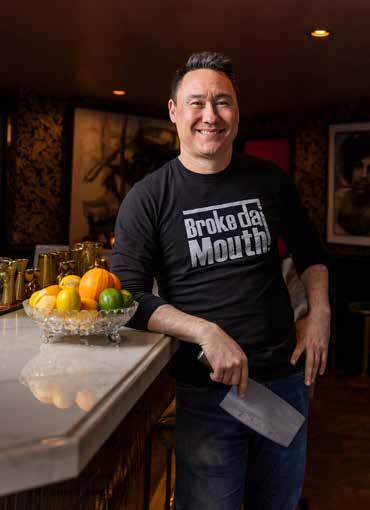


ARCHITECT
Ripple Design Studio
INTERIOR DESIGN
Lisa Staton
PHOTOGRAPHY
Michael CLifford Photography
BUILDING FINE HOMES ON MERCER ISLAND SINCE 2005






THE EXCEPTIONAL VISION OF GARY FURUKAWA
GaryFurukawa,Founder
- Freestone CapitalManagement

ARTICLE BY CHRIS ISHII | PHOTOGRAPHY BY SASHA REIKO, FURUKAWA FAMILY GALLERY
Some people see things just a little sooner than the rest of us. Gary Furukawa, founder of Freestone Capital Management, has built a career and a reputation on spotting trends early, thinking differently, and making bold moves that weren’t always the most popular at the time—but ultimately proved to be ahead of the curve.
From his days on Wall Street to launching Freestone in 1999, Gary has consistently demonstrated an ability to see where the industry is going , rather than where it is. His investment philosophy, focus on deep financial planning, and forward-thinking approach to wealth management have allowed him to thrive in an industry that has undergone massive changes over the past two decades.
"When we started in 1999, the independent Registered Investment Advisor space was nascent and just starting to emerge as an industry," Gary recalls. After 17 years as an investment advisor with large Wall Street firms, he envisioned something different: "The original idea for Freestone was to create a firm where clients’ interests always came first, even if achieving this goal was detrimental to Freestone as a business."
At the time, most financial advisory firms were still closely tied to big brokerage houses, selling commission-based products rather than acting as true fiduciaries. But Gary saw the shift coming early—the future of wealth management, he believed, was in independent advisors who could truly put clients first , offering customized advice free from conflicts of interest.
"When we started, we managed stock and bond portfolios and did a little financial planning," Gary explains. "Today we manage a variety of investment strategies, including direct real estate, private equity, and energy. Heavy-duty financial and estate planning has become the most important service we offer."
As an investor, Gary has always taken a thoughtful, long-term approach , with an eye on both opportunities and risks that others may overlook.
"We have a unique set of issues facing us today," he warns. "High valuations, geopolitical unrest, and new technologies like Artificial Intelligence that hold great promise—but also the potential to ruin society. We think now is a good time to be more careful than normal with risk levels."
“WE HAVE A unique SET OF ISSUES FACING US TODAY. HIGH VALUATIONS, geopolitical unrest , AND NEW TECHNOLOGIES LIKE Artificial Intelligence —WHICH HOLD GREAT PROMISE BUT ALSO THE potential TO RUIN SOCIETY.”GARY FURUKAWA

Even though Freestone has grown into one of the leading independent advisory firms, Gary acknowledges that not every decision was made at the right time.
"We were kind of slow to emphasize heavy-duty financial and estate planning," he admits. "In hindsight, we should have done it earlier. I feel like we've caught up now and even gotten ahead of the curve—and clients really value this type of life-changing advice."


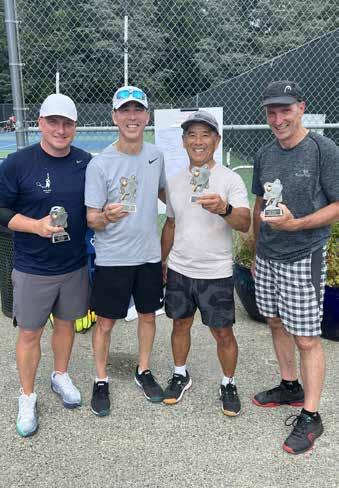
Gary credits Mercer Island with shaping much of his professional and personal worldview.
"We lived on Mercer Island from 1992 to 2008, and most of our four kids' lives were spent on the island," Gary reflects warmly. "I have fond memories of coaching baseball and meeting so many great parents. We really loved the family-oriented atmosphere of Mercer Island and met almost all of our current good friends at the Mercer Island Country Club playing tennis."
That sense of community has endured. In June 2024 , Gary and longtime friend Mike Hartmann won the Mercer Island Country Club Pickleball Tournament . The celebratory photo, showing Gary alongside Chris Pavlin , Gerald Chew , and Hartmann, captures the kind of camaraderie that makes the Island so special. "All Mercer Island residents," Gary notes with a smile.
Another snapshot of this enduring bond is from a 2023 Backroads biking trip through Tuscany, where Gary joined a group of current and former Mercer Island residents. The photo speaks to a life rich with friendships, shared experiences, and the active lifestyle that so many Islanders cherish.
Gary Furukawa’s story resonates because it’s about more than financial success—it's about having the courage and clarity to trust one’s vision, even when it’s unpopular. It's about foresight , integrity, and putting people first —principles that Islanders deeply appreciate. Indeed, the Mercer Island community has been fortunate to call Gary one of their own.
And as the world of investing continues to change, one thing is clear: Gary will be paying attention to what’s next, long before the rest of us catch on.




“The lack of attainable housing is a supply and zoning issue.”
In neighborhoods across Mercer Island, Bellevue, Kirkland, and Snohomish, a quiet but powerful shift is underway. Backyards, driveways, and empty side lots may soon take on new life, thanks to House Bill 1110 (HB 1110)—a bold new law reshaping residential zoning across Washington State.
Passed in 2023 and now taking effect, HB 1110 requires many cities to update zoning codes to allow two to six housing units on parcels previously limited to a single home. That means duplexes, triplexes, fourplexes, and cottage-style clusters could soon sit side by side with traditional houses.
The question isn’t whether change is coming. It’s: How ready are we to shape it?
Washington’s housing shortage didn’t happen overnight. For years, demand has outpaced supply, pushing home prices beyond reach for many families. Zoning restrictions that limit development to one home per lot—particularly in job-rich cities like Bellevue and Kirkland—have made it difficult to accommodate growth.
“Three-quarters of Seattle’s land is still zoned single-family,” says Dean Jones , President and CEO of Realogics Sotheby’s International Realty (RSIR) . “That model worked in the 20th century—but not for the realities of today. HB 1110 is potentially offering more attainable ways to live where you work.”
And this is not optional. For cities with populations over 25,000—including all four highlighted in this magazine—HB 1110 is a mandate
Picture this:
• A homeowner builds a backyard cottage for a parent or tenant.
• A single-level home is thoughtfully redeveloped into a triplex.
• A corner lot transforms into a small cluster of homes, designed to complement the neighborhood.
This is called “ missing middle housing”—a style of gentle density that fills the gap between single-family homes and large apartment buildings. And it’s exactly what HB 1110 encourages.
According to real estate economist, Matthew Gardner, “The lack of attainable housing is not just a supply issue—it’s a zoning issue. Missing middle housing helps solve both by increasing inventory without changing the character of our communities overnight.”
Still, navigating these changes isn’t easy. That’s where technology and expertise come in—and why RSIR has become a recognized leader in this space.
Dean Jones and his team aren’t just interpreting the law—they’re building the future. RSIR is piloting AI-powered tools that analyze zoning, land potential, and market value—helping brokers and property owners understand what’s possible.
At the center of this innovation is Tadashi Shiga and Ofer Avnery, Co-Founders of Realtie, an AI platform built to streamline infill development. Realtie lets users visualize development potential, model financial returns, and identify risks—all before the first permit is filed.
“Most homeowners don’t realize they’re sitting on untapped potential,” Shiga says. “With the right insights, a single lot can become a retirement plan, an income source, or a multigenerational solution.”
He and Jones are working closely to train brokers, educate communities, and connect residents with a full-service ecosystem—from planning to permitting to resale.
This new framework opens doors for:
• First-time buyers priced out of traditional homes
• Multigenerational families wanting to stay close
• Empty nesters seeking to downsize or generate rental income
• Longtime residents who may want to develop or sell strategically
Gardner emphasizes, “The shift isn’t just about affordability. It’s about retaining community. These homes allow the people who serve, teach, and support our cities to live here too.”
For sellers, these changes can dramatically increase the value of their land. For buyers, they open up new paths to homeownership. For neighborhoods, they bring fresh energy—while preserving the spirit of place.
Naturally, some residents worry about traffic, parking, and infrastructure. Others fear rapid development or disruption of neighborhood character. These are real concerns—and cities are taking them seriously with implementation timelines, design standards, and public input.
Gardner asks,
“How can we encourage companies to move to the Pacific Northwest if housing prices are so
high that they simply cant afford to pay employees enough for them to be able to own a home?”
• Explore your city’s plans – Each municipality is rolling out its own approach. Visit planning websites, attend open houses, and stay informed.
• Talk to a professional – From architects to lenders, planners to Realtors, the right team can help you understand your property’s true potential.
• Start the conversation – With neighbors, with family, with city leaders. This is a shared journey, and your voice matters.
This isn’t about density for density’s sake. It’s about building a future where our children can afford to live nearby. Where aging parents can move into a backyard cottage. Where creative solutions meet real needs.
As Gardner puts it: “The neighborhoods we build today will shape the lives of the next generation.”
House Bill 1110 invites us to rethink the boundaries—of our lots, our zoning, and our assumptions.
It’s about rewriting the neighborhood, yes.
But more than that—it’s about reimagining what community can be.

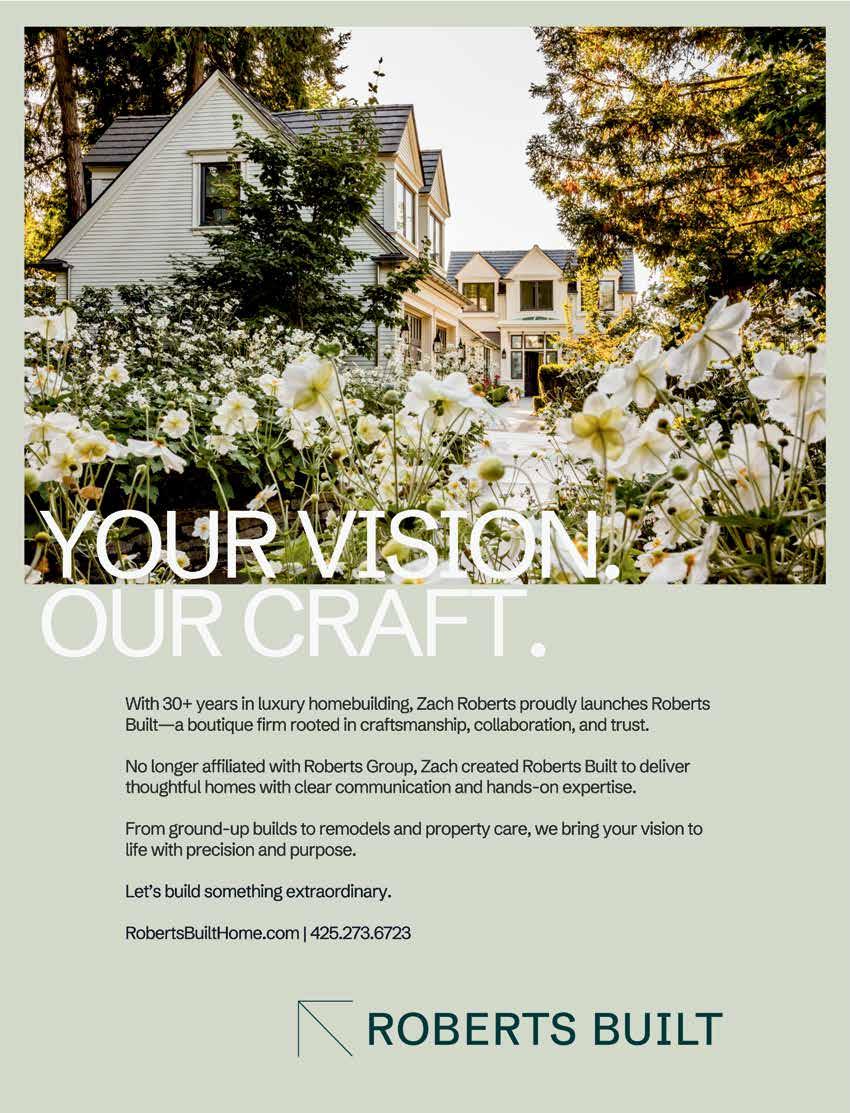
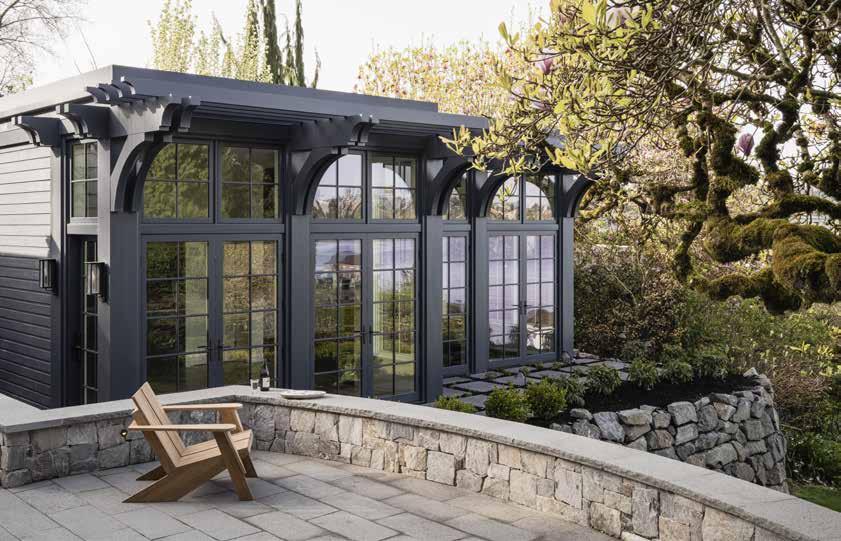



It often starts as a simple idea—a comment made in passing, a room above the garage, a quiet space in the basement, or a patio just waiting for purpose.
“I’ve always wanted a space of my own.”
But in the homes we’re featuring here—beautifully built by Gallagher & Co. with added expert insights from Hi-Tek Group and Baklinski Home Improvement—those simple ideas become something greater: a room with presence, purpose, and a magnetic draw that goes far beyond one person.
Today’s man space is more than a place to retreat. It’s a space to connect, restore, entertain, and live—designed around personal passions but destined to become a family favorite.
Each Gallagher & Co. project reflects this shift.
The Garman project features a sleek wellness pavilion tucked into the landscape. Designed with Studio AM Architects and interiors by Kat Lawton, and photographed by Kara Mercer, it includes a top-tier golf simulator—a space that offers both high-performance recreation and effortless hosting potential. Whether it’s used for quiet practice, coaching the kids, or friendly
competition, the versatility is built in. It’s a space that encourages movement, connection, and lingering longer than planned.
In the Peyree project, Gallagher & Co. collaborated with Gelotte Hommas Drivdahl and Hilary Young Design Associates, with photography by Tim Van Asselt, to reimagine a lower-level basement as a richly layered man cave retreat. With moody lighting, classic materials, and refined furnishings, it’s a room that exudes calm and confidence. Ideal for curling up with a good film or opening a vintage bottle, it shows how design and atmosphere can create an environment that quietly invites others to join.
The Perla project turns outdoor living into a true extension of the home. Working with Silk Cavassa Marchetti and Cook Design House, and photographed by Emily Minton Redfield, Gallagher & Co. created a grill master’s oasis—complete with built-in cooking elements, lounge seating, and layered lighting. While the layout
Opposite Left Top: “Golf Simulator” -
Photography by Kara Mercer
Opposite Left Bottom: Photography by Gallagher & Co.
Opposite Right Bottom: Photography by Gallagher & Co.
Above: “Grill Master” - Photography Emily Minton Redfeild
“WE DESIGN SPACES THINKING THEY’RE GOING TO BE FOR ONE PERSON. BUT ONCE THEY’RE FINISHED, EVERYONE WANTS IN.” HI-TEK GROUP
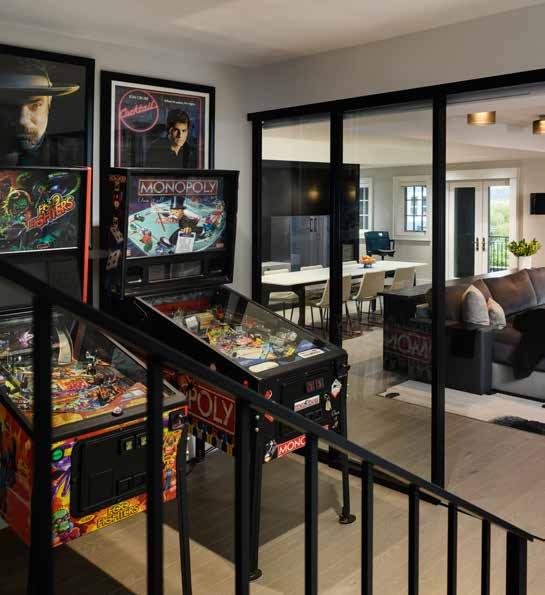
celebrates culinary craft and independence, the open-air design and gathering zones encourage everything from spirited dinner parties to spontaneous weekday evenings outside.
These projects weren’t built as crowd-pleasers—but their thoughtful design, natural flow, and lifestyle-forward functionality suggest that they’re likely to become just that.
While these spaces impress visually, much of what makes them extraordinary lies behind the scenes.
Hi-Tek Group’s Albert McRae explains that today’s man spaces run on an invisible infrastructure: a strong network that powers everything from lighting and security to sound, temperature, and even patio heaters.
“Everything lives on the network now,” Albert says. “If you want the room to shift from solo retreat to social hub with a tap or voice command, that’s what makes it possible.”
And when it comes to mood and energy, Brian Webb emphasizes the role of sound.
“Sound shapes the soul of the room,” he says. Brian points to a project where Hi-Tek designed a home theater above a garage. It began as a personal escape—with a projector, two-channel vinyl system, and immersive audio—but quickly became a hub for the whole family. From movie marathons to gatherings with friends, what started as

a man’s dream evolved into a shared, multigenerational favorite.
That transformation is something Brian sees often: “We design these spaces thinking they’re going to be for one person. But once they’re finished, everyone wants in.”
For Andrew Baklinski of Baklinski Home
Improvements, the magic is in the detail—and the emotion. He recently led the design and build of a frameless glass wine room installed in a home’s entryway. The result was striking, climate-controlled, and a true showpiece.


“It’s not just about storage,” Andrew says. “It’s about creating something beautiful and personal. When we get it right, there’s a pause. People walk in and say: ‘Wow.’ That’s what we aim for.”
Andrew believes that the best man spaces give something back. They restore. They reflect. They allow someone to recharge—so they can show up stronger in every area of life. “Life is intense,” he says. “We all need that space to breathe, reset, and feel like ourselves again.”
What sets these spaces apart is how naturally they become places to gather.
A golf simulator invites friendly competition.
A vinyl station sparks nostalgia and storytelling. A built-in wine wall or bar draws guests like a magnet.
Multi-zone lighting and sound, designed by Hi-Tek, shift the energy with a single command.
What begins as personal often becomes shared—sometimes unexpectedly. These rooms may feature masculine design, but their function is universal. They offer comfort, mood, and curiosity. They invite others in.
They become the place where game nights unfold, stories are told, and birthdays are celebrated. They become the new heart of the home
These aren’t “man caves” anymore. They are living chapters of the home—deeply personal, but also widely loved.
They’re not about hiding away.
They’re settings where everyone feels a little more relaxed, a little more curious, and a lot more welcome. They begin with a dream—and evolve into a destination.
So here’s the question to take home: What would your space look like?
Would it be a place for music, movies, wine, golf, grilling, or restoration?
Would it be yours—and also theirs?
Because in the end, a man’s space isn’t just about him. It’s about how he shows up for everyone else.


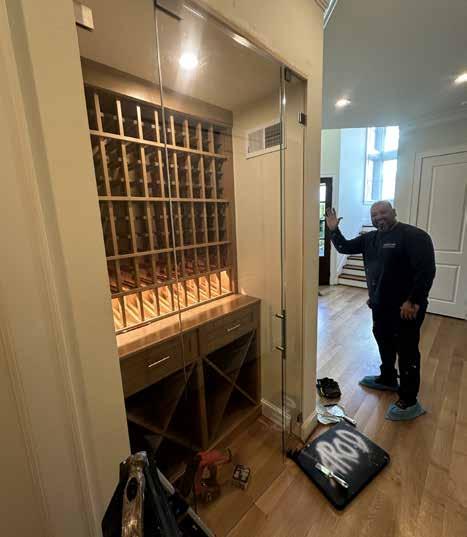









The ultimate man-cations for the discerning gentleman, balancing rugged adventure with refined comfort
ARTICLE BY BRENDA EL-GHAZZAWY PHOTOGRAPHY BY LUXXE TRAVEL
Premier lodges across the American West and Alaska offer immersive experiences—pairing outdoor pursuits with destinations that blend grit and grandeur.



Nestled on 6,600 private acres near Philipsburg, The Ranch at Rock Creek sets the standard for luxury ranch experiences. Guests can engage in fly fishing, horseback riding, and clay shooting by day, then unwind in bespoke accommodations ranging from historic cabins to glamping tents. Evenings feature gourmet dining and curated whiskey tastings with rustic charm.
Overlooking the Yellowstone River, Sage Lodge offers a contemporary take on the classic lodge experience. Outdoor enthusiasts can fly fish, hike, and bike, and Yellowstone National Park is just a short drive away. The lodge’s Fireside Room serves hearty, locally sourced meals—perfect for recounting the day’s adventures.
Situated on a 3,500-acre private ranch near Park City, The Lodge at Blue Sky by Auberge Resorts Collection offers alpine adventure in an elegant setting. Activities include heli-skiing, horseback riding, and fly fishing, all tailored to guest preferences. Accommodations range from creek-side cabins to expansive suites with panoramic views. After a day outdoors, guests can relax at the Edge Spa or enjoy a tasting at the High West distillery.
Accessible only by boat or float plane, Dove Island Lodge in Sitka offers an exclusive Alaskan fishing experience of king salmon, halibut, and trophy steelhead in pristine waters, and the option of fly-out excursions to remote streams via the lodge’s private De Havilland Beaver floatplane. Oceanfront suites have private hot tubs and fireplaces, and the lodge boasts gourmet meals and the most extensive wine cellar in Sitka.
These exceptional lodges offer curated experiences where adventure meets luxury for those seeking to disconnect from the everyday and reconnect with nature in style.
To learn more contact Luxxe Travel at luxxe.travel, your VIP Travel Concierge Services on Mercer Island.














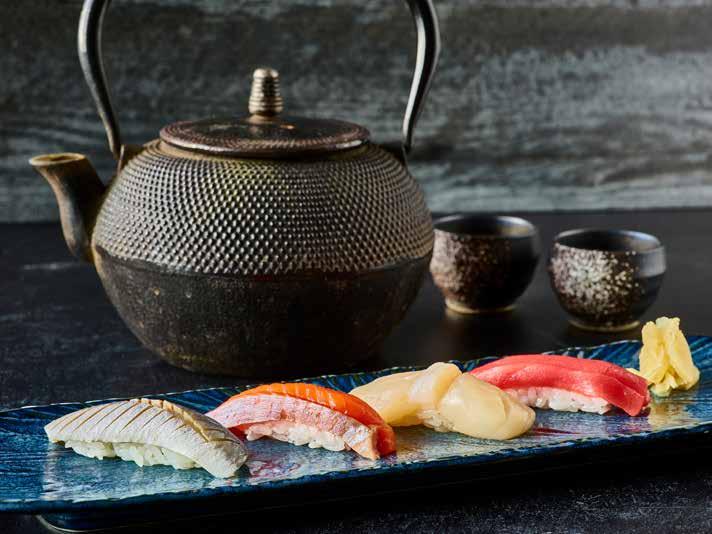




FROM BOYHOOD TO FATHERHOOD: HOW DOGS WALK BESIDE EVERY MAN
If you’ve ever felt like your dog understands you better than most humans, you’re not alone.

ARTICLE BY CHRIS ISHII PHOTOGRAPHY BY ISLAND ANIMAL HOSPITAL
Whether it’s the tail-thumping greeting when you walk through the door, the quiet companionship during tough days, or the excuse to get outside and move, our dogs often know what we need before we do. And if you’re a dog owner, chances are you’ve already felt this connection—that quiet understanding that your four-legged friend is more than a pet. They’re family. Sometimes, they’re your best friend.
That’s exactly how it started for Dr. Peter Brown, founder of Cara Veterinary. His first best friend wasn’t a classmate—it was Bo, a big, lovable black lab mix who met him at the school bus every day after Peter’s family relocated to a farm in Ellensburg. “We’d just moved from Bellevue,” Peter recalls. “I didn’t know anyone. Bo was my everything—my companion, my confidence, my comfort zone.”
Bo’s story took a dramatic turn when he was hit by a car—an accident that led Peter into a veterinary clinic where, as a sixth grader, he assisted in the surgery that saved his best friend’s life. “That was the moment,” he says. “The moment I knew what I wanted to do with my life.”
Since then, Peter’s life and career have been shaped by the dogs who’ve walked alongside him—each one entering a different chapter and bringing exactly what was needed.
And maybe, as you’re reading this, you’re thinking about the dog who got you through a breakup. The pup who taught your kids how to be gentle. The one who trained with you for that first half-marathon. Or maybe it’s the rescue curled at your feet right now.
Peter’s current companion is Griffey, a bouncy, affectionate 80-pound pit bull mix who joined the family during Bark at the Park at a Mariners game. “I’m the veterinarian for the event, and we were doing adoptions that night,” Peter says. “But it wasn’t so much that we picked Griffey. He picked us.”
Named in honor of Seattle legend Ken Griffey Jr., this rescue pup from Eastern Washington has become a focal point in Peter and his wife’s post–empty nest life. “We’ve made friends because of him. We’ve found trails we’d never explored. Our whole rhythm shifted—and for the better.”
Peter’s insights as a veterinarian are backed by decades of research—and one mentor in particular shaped how he sees the human-animal bond: Dr. Leo Bustad, the former dean of Washington State University’s College of Veterinary Medicine and one of the earliest pioneers in the field of human-animal interaction.
“Leo believed deeply that dogs didn’t just serve roles—they had relationships,” Peter explains. “He was the first person I heard say that dogs provide purpose. That they’re not here just to herd sheep or retrieve ducks. They’re here to love— and be loved in return.”
CONTINUED >

Bustad’s work revealed that dogs in the home significantly impact mental and physical health. Former inmates returning to homes with pets showed lower recidivism rates. Elder care facilities with pet-friendly policies saw reduced reliance on medication. College students reported lower stress during finals after just a few minutes of contact with therapy dogs.
“Touch a dog, and your blood pressure drops,” Peter says. “Your breathing slows. Your anxiety lowers. It’s real. It’s measurable. And it’s powerful.”
Even more fascinating? Dogs may have selected us, not the other way around. “Anthropologists now believe early canines approached humans, not the other way around,” Peter shares. “The friendliest ones got food—and warmth. Over time, we selected for that friendliness. The bond we have today? It’s built on thousands of years of mutual benefit and trust.”
It’s why Peter advocates for increasing access to dog companionship—especially for people who need that calming presence the most. “There are plenty of dogs who need homes,” he says. “And plenty of people who need a dog. Connecting the two can change lives.”
Chances are, if you’ve had a dog, you’ve experienced at least one life stage where their presence made all the difference. Maybe they helped you get through the loss of a parent. Or kept you company during remote work. Or gave your family joy during the long isolation of the pandemic.
Peter has seen it all—from marathon training with his golden retriever Terry to caring for his aging parents as their yellow lab Abby kept them active and grounded.
“I can’t imagine my life without dogs,” he says. “Each one brought something unique, exactly when I needed it.”
And maybe that’s true for you, too.
Whether you’ve got a puppy at your heels, an old soul snoozing nearby, or a beloved memory etched into your heart, one thing is clear: the dogs in our lives shape us, steady us, and stay with us— even long after they’re gone.
So tonight, maybe add an extra minute to the walk. Toss the ball one more time. Or just sit still and soak in the quiet companionship.
Because if you’re lucky enough to be chosen by a dog… you already know: that love changes everything.












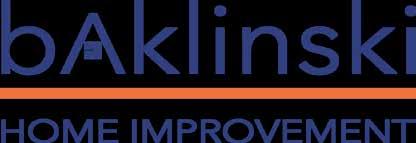
JUNE 2025
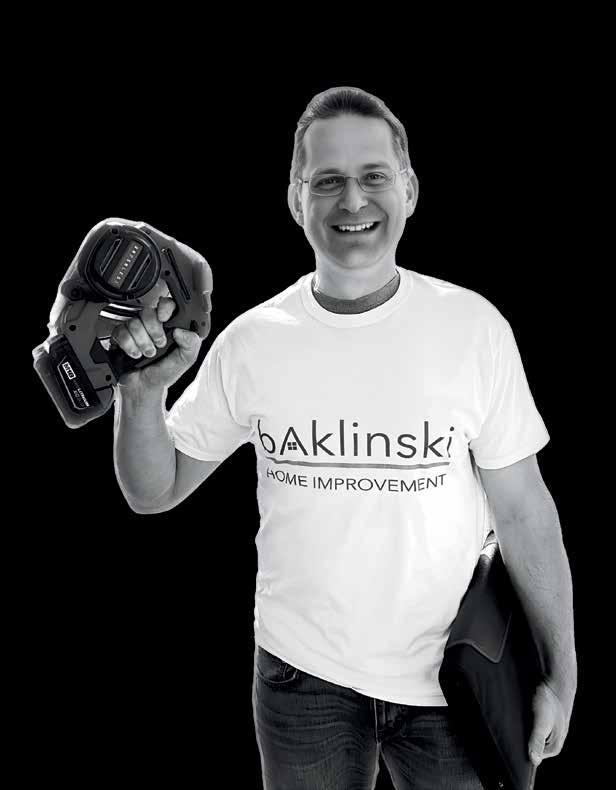






A SELECTION OF UPCOMING LOCAL EVENTS
JUNE 1ST
Mercer Island Farmers Market
Mercerdale Park | 10:00 AM
Sunday, June 1, Opening day of the Mercer Island Farmers Market 2025 Season! Every Sunday 10am-2pm at Mercerdale Park. Fresh produce, locally prepared foods, live music, beautiful community.
June music:
6/1 Yaamba Marimba
6/8 Ranger and the Rearrangers
6/15 Zach Lombardo
6/22 Si Tu Savais
6/29 The Djangomatics
More info @ www.mifarmersmarket.org
JUNE 5TH
Thrive in 25 - The Future of Homeownership Starts Here
Kirkland Performing Arts Center | 9:00 AM - 12:00 PM
Join the conversation at the THRIVE IN ’25 Industry Summit—where bold ideas meet real impact. Discover how AI is transforming homeownership and what House Bill 1110 means for your property’s potential. Join top economists, visionary builders, and early adopters leading the next wave of innovation. Optional lunch at Moss Bay.
Presented by Realogics Sotheby’s International Realty and partners.
JUNE 5TH
Mosaic MI Open Mic Night and Listening Session
Aljoya Mercer Island 2430 76th Ave
SE Community Room | 7:00 PM
Join Mosaic MI open mic night for an evening of music, connection and community! Come as a performer
or listener - there’s a place for you here. Lottery pick for 10 performers, 10 minutes each, open to high school and older, all skill levels welcome. Come listen and be part of the mosaic. Free, donations welcome.
JUNE 6TH
Mercer Island First Friday Art Walk
Mercer Island Town Center | 5:00 PM
Celebrate local creativity on Friday, June 6 , 5–8 PM as Island galleries and businesses showcase featured artists. Stroll, sip, and enjoy community connection through art. Start your evening at Clark & Clark for a map and refreshments. All are welcome—come be inspired and support the arts on Mercer Island!
JUNE 14TH
Island Youth Ballet’s Alice in Wonderland
Mercer Island High School
Performing Arts Center | 2:00 PM
Join Mercer Island Children’s Dance Conservatory and Island Youth Ballet for a whimsical journey down the rabbit hole in Alice in Wonderland! This enchanting production features talented local Mercer Island dancers and will be performed on Saturday, June 14, 2025, at 2:00 PM at MIHS. A magical experience for audiences of all ages!
Tickets and more information @ www.childrensdance.org/performances
JUNE 19TH
Juneteenth Community Celebration 2025
Mercerdale Park | 12:00 PM
Mercer Island High School Black Student Union will host a Juneteenth Community Celebration 12-4 p.m. on June 19 at Mercerdale Park. The event is sponsored by the City of Mercer Island and will feature live music by the MIHS jazz quartet, face painting and a balloon artist; the MIHS drill team; Black-owned food trucks; and 88.9 KMIH The Bridge.





ARTICLE BY MEL BOBAN


Enjoy a movie night together with popcorn, candy and all the fixings. Home movies enable strolls down memory lane, or one of his favorite movies from his childhood makes for fun conversation. Ordering a projector for a large format screening makes the movie night feel extra theatrical.
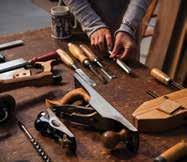
Learning a new skill together, or sharing a favorite hobby, is a great way to bond. If Dad likes woodworking or fishing, finding a class to attend together goes beyond gifting tools and allows fun.

Brainstorm childhood memories together and enjoy a day reliving them. If he chaperoned a trip to the zoo, experience it again together. If short on time, stop at a favorite ice cream stand and tell him how much you cherish the memories.


